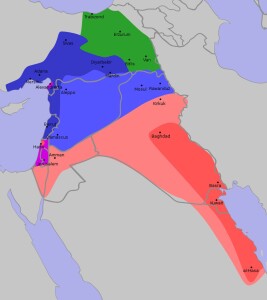Our weekly column from the humor site PreOccupied Territory.
Check out their Facebook page.
 Jerusalem, February 23 - Since time immemorial, the indigenous people of Palestine have lived in their native land, bound on the west by the Mediterranean Sea and to the north, east, and south by frontiers established by the British and French in the waning days of the First World War, beyond which Palestine never existed.
Jerusalem, February 23 - Since time immemorial, the indigenous people of Palestine have lived in their native land, bound on the west by the Mediterranean Sea and to the north, east, and south by frontiers established by the British and French in the waning days of the First World War, beyond which Palestine never existed.
Ancient texts and modern lore speak of a bucolic Palestine that saw conquest after conquest, its native population anchored to the land through thick and thin and defining themselves as the children of it, so thoroughly that the term "Palestine" never passed their lips. From the Biblical era to the premodern, as empires and administrative boundaries shifted, and as populations migrated, never did a parcel of land beyond the lines drawn by Sykes and Picot answer to the term "Palestine," except for the eastern two thirds of the British Mandate for Palestine that became the Hashemite Kingdom of Jordan and thus retroactively disqualified from the descriptor "Palestine" back into history.
The cultural, demographic, and ethnic spectrum that characterizes modern-day Lebanon, Syria, Egypt, and Jordan seldom shifted in any appreciable way upon traversing the 1916 borders of Palestine; the Levantine cuisine, religions, mores, and customs of Palestine have defied, for millennia, outsiders' attempts to impose nomenclature and geographic definitions, except for the British and French at the end of World War I and their respective defeat of the Ottomans establishing the ancient border between Palestine and Lebanon at the point where the British and French zones met, and except for the Ottomans not considering "Palestine" an entity at all, since the term featured primarily in European Christian use since Roman times.
Ancient Palestinians inhabited the south of country as defined by the 1949 armistice lines between Israel and Egypt and between Israel and Jordan; if they existed, ancient sources would speak of the strong blood, commercial, and cultural ties between the Palestinians of south Palestine and their healthy relations with the inhabitants of Jordan, established in the 1920's, to the east, and Egypt, sovereign since 1946, to the west. Many Palestinians in the Gaza Strip boast of ancestry and family in Egypt, which controlled the Strip from 1949 to 1967, during which time the Palestinians of the Gaza Strip never felt the need to assert their belonging to Palestine, so secure was their identity as Palestinian.
Palestinian scholars speak with similar reverence of the holy Islamic shrines in Jerusalem, which as recently as the 1920's they touted as undoubtedly built on the same site as the Temple of Solomon, that famous Palestinian ruler.
|
Or order from your favorite bookseller, using ISBN 9798985708424. Read all about it here! |

|

 Elder of Ziyon
Elder of Ziyon


















.jpg)




